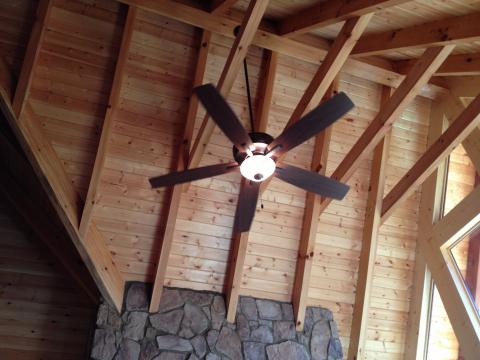What are the differences and similarities in roof systems, and why is it important?
A few basic types of systems exist for homes. Depending on your location, and what types of snow loads, wind loads and other geographic design specs, are all primarily the same in basic function. They all keep the elements out, and help keep the temperature controlled air in, but what are the differences? Take a look below for the five minute answer.
First, lets describe the roof systems. Below we will quickly touch on stick built roofs using conventional framing materials, trusses and our premier heavy timber roof systems.
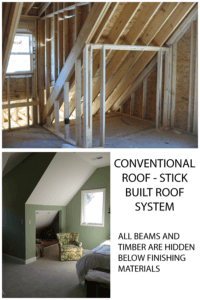 Conventional Framing Roof (stick built):
Conventional Framing Roof (stick built):
As the name suggests, stick built roofs are built one piece at a time on site by the carpenter or crew. The bottom cord is typically nailed into place, often with no use of gusset plates, and bracing is applied as the roof goes together. The advantages in some areas of the country are beneficial to this type of construction, and if trusses aren’t used, wait time is practically cut to nothing. Fast carpentry crews can make quick work of a roof if given the proper materials and engineered blueprint schematics on the method to build the system. If properly followed, this system is a great way to save money, but is more labor intensive and requires more time to build on site.
While stick built roofs can be cost effective, depending on where you live, this may not be the best way to design and build your roof. For example, in parts of Alaska, where the snow load runs as much as 300lbs per foot, a stick built roof would require more engineering and much heavier materials than in our area here in East Tennessee. In heavy loading situations, a truss can be built in a factory where the manufacturer can build according to the loads for each area. The advantage of this is that the engineering is already in place to help ensure your home will meet the required loading. Plus, if given enough notice trusses are a much faster way of putting a roof system together. Depending on many variables, a roof can often be builT using trusses in a day or two versus a week or two by most trained carpenters on a standard home.
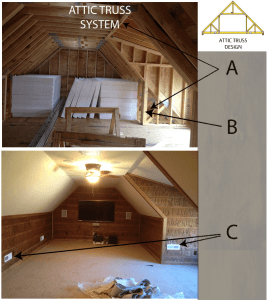 Truss Roof Systems:
Truss Roof Systems:
As we touched on above, this type of roof system has pros and cons depending on where the home is being built, the experience level of the builder and the amount of engineering involved to make a structurally sound roof for the given geographic location. What we didn’t speak about was the different types of trusses that can be used. While the function is exactly the same, you might be able to claim more living or storage space using an attic truss, for example. Or, if you like the cathedral ceiling look, you can often use a vaulted scissor truss for this effect.
If you plan on using every sq ft in your home, attic trusses can be a great way to get that needed storage for much less money than the cost of most homes traditional square footage and living spaces. By using a truss designed to allow for open space, you can either finish the area,such as for a walk in closet or man cave, or simply install 3/4 floor sheating to grab areas and use them for storage. We would recommend, if you are simply planning for storage and think you might one day finish this space, insulate the floors, walls and ceilings beforehand. This is a relatively low cost, and if you decide to finish this area, you won’t have to rip anything up to properly insulate the area.
As the illustration to the left shows, areas otherwise not useable can be reclaimed into living space. Figure “A” shows the areas where heating and air ventilation and air ducts can be installed. Figure “B” shows the knee wall required by this type of design. Not all areas are usable, but this is a much better option than having dead, unusable space. Figure “C” shows installed air vents, which would be required if the area will be finished. Our picture is of an area above an attached garage. This was converted into a “Man Cave” by the owner, and as a nice plus, this area is easily accessable from the main living area of the home.
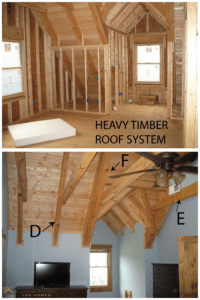 Premier Heavy Timber Roof Systems:
Premier Heavy Timber Roof Systems:
Heavy timber framing, such as the images below, are a way of bringing the timber look into your home, and if instaled properly, are more energy efficient than the other systems described. These roofs are much like the traditional stick built systems described above, but due to the massive size of the beams and timbers, the spacing can be stretched wider than the typical 16″ for stick built, or 24″ for trusses. Most of the heavy timber roofs utilize a tongue and groove decking, ours in a 2×6 thickness, as opposed to the 3/4 or 5/8 sheathing on trusses and stick built.
These are more expensive than the other methods, but if built correctly, can be even more energy efficient than the other methods. Areas of concern in Heavy Timber Roof Wiring, which must be notched and pre-cut into the beams to conceal eletrical items. Also, when the Heavy Timber Second Floor is used with the Roof, extra care must be taken not to place these in the same locations. Our standard log cut sheets and heavy timber framing layouts are a must when using these systems. Unfortunately, next to SIPs (Structurally Insulated Panels), this is one of the most expensive systems available for a roof. (This illustration shows “D” – Heavy Timber Rafter, “E” – Timber Collar Tie, and “F” – Heavy Timber Header Beam. Each of these are structural.)
Hybrid Roof Systems:
The Hybrid Roof system combines the conventional framing systems with false heavy timber beams. This can be made to look exactly like the Heavy Timber Systems, but by using either trusses or stick built framing in combination with either decorative beams or false timber, the costs are much lower than the full Heavy Timber System. The panels that are used in Heavy Timber Systems can be replaced with standard bat insulation, 2×6 tongue and groove is replaced with roof sheathing or 3/4″ or 5/8″ in most areas, and instead of making the timber structural, the spacing and placement of the timber can be wider spacing, which allows for fewer beams, and much smaller timber can be used since the structure is provided in the truss or conventional roofs. Another advantage is the changing of materials this system will allow. You can finish your ceiling with any materials as opposed to only the 2×6 tongue and groove. For example, if you would like a sheetrock walls with a heavy timber look, this system will make that possible.

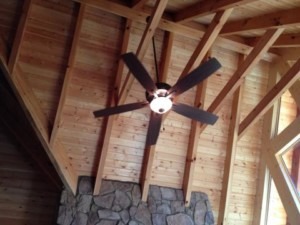 Here are a few illustrations of true heavy timber and false decorative beams in a couple of our past homes.
Here are a few illustrations of true heavy timber and false decorative beams in a couple of our past homes.


